By Sean Fagan
.
.
LEARN 9 BUSHCRAFT USES OF HOLLY
In a rush? Article summary here 9 Bushcraft Uses of Holly
.
According to the medieval Brehon laws of Ireland, if someone was caught illegally felling a holly tree the culprit was obliged to owe the landowner the hefty fee of two milking cows.
During that time period trees were categorised into four divisions according to there cultural and practical value. The highest value division was the Airig Fedo division.
Airig Fedo is a Gaelic phrase meaning Nobles of the Woods.
Only 7 native trees were bestowed the lofty status of a noble: oak, hazel, yew, ash, pine, apple and holly (1).
What made holly a valuable tree was its tough, heavy wood which was favoured, during those times, for making spears and chariot axles – both understandably much valued items during the periods of strife that was widespread during that era.
Holly was also an essential fodder crop. The nutritious, evergreen leaves of holly was the perfect fodder crop for livestock during the lean months of winter.
Holly leaves were an important winter fodder in parts of Ireland as recently as the 1950’s, until replaced by hay as the primary winter fodder (2).
Identification
of
Holly, Ilex aquifolium
Alternative names: Hulver Bush, Holm, Holy tree, Christ’s Thorn, European Holly, Common Holly, English Holly.
Family: Aquifoliaceae
Distribution: Generally common in Ireland and Britain, often found as an understory tree of native, deciduous woodlands or part of a hedgerow system. Found throughout most of central and south Europe.
.
KEY IDENTIFICATION FEATURE OF HOLLY...
SPINY, LEATHERY LEAVES!
Glossy, dark green, upper leaf surface. Under surface of leaf is light green.
.
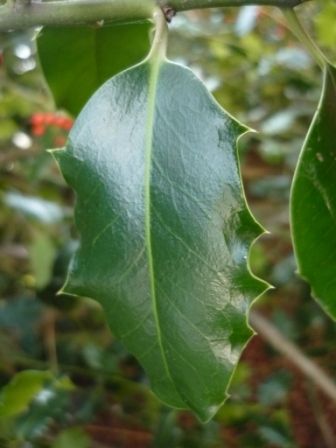
Holly is evergreen. Its characteristic, spiny leaves are present through out the year (Photo: Sean Fagan).
Flowers: Fragrant, white, four-petalled & small (6-10mm). Unusually, the petals have a leathery, waxy texture. The flowers originate from the leaf axils (the junction between the leaf stem (petiole) and the twig its attached to).
.
Buds: Small (2-3mm long), green, hairless and pointed.
Bark: In its youth, holly bark is smooth and usually of a light grey colour. With age, the bark becomes progressively rougher. There can also be a number of small protuberances protruding from mature bark.
.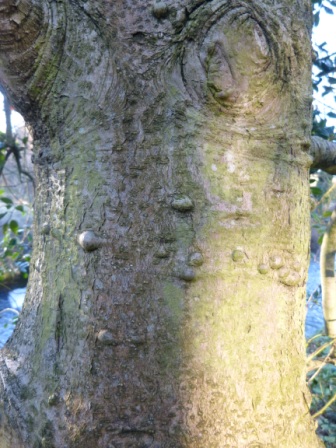
The bark of mature holly is noticeably rougher in texture and appearance and can have a number of small bumps on the bark (Photo: Sean Fagan).
.
Profile: Holly is generally a small tree, and slow growing. The overall shape is often domed or conical. Often, holly trees will refuse to take on a neat shape and have a somewhat straggly, dishevelled appearance.
.
Berries: Female holly trees produce clusters of striking, coral-red berries.
Poisonous to humans but edible for a lot of wildlife.
Important food item for winter-visiting, migratory thrush species such as the fieldfare, Trudus pilaris, and redwing, Turdus iliacus. Often, mixed flocks of both species can be seen descending on berry-laden hollies during winter - gobbling away to their hearts content.
The hard berries of holly soften after exposure to frost and provide much needed, cold-weather sustenance for not only for bird species but also some mammal species, such as the red squirrel and pine marten (very partial to berries, despite its fearsome reputation).
.
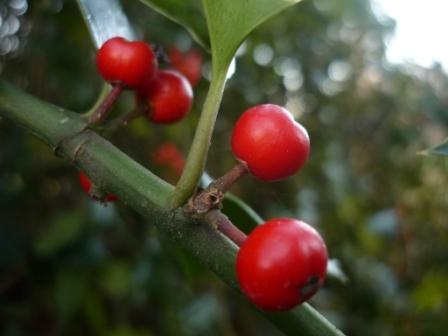
The striking red berries of holly - an important winter-survival food for quite a few mammal and bird species (Photo: Sean Fagan).
.
9 BUSHCRAFT USES OF HOLLY
The holly is a great bushcraft tree. Below is a list of 9 bushcraft uses of the holly tree. 1. KINDLING 2. FUEL 3. CARVING WOOD 4. FEATHER STICKS 5. FLAMMABLE BARK 6. BOW-DRILL LUBRICANT 7. LONG, STRAIGHT BRANCHES 8. NATURAL SHELTER 9. LEAF LAYER OF DEBRIS HUT1. KINDLING The branches of living holly tree possess an unusually high number of attached, dead, thin, long and flammable twigs.
They are often of ideal length, dryness and thinness for the small twig fire, and just as importantly - it’s possible to collect many dead, holly twigs in a short period of time – important, if you need to get a fire going quickly.
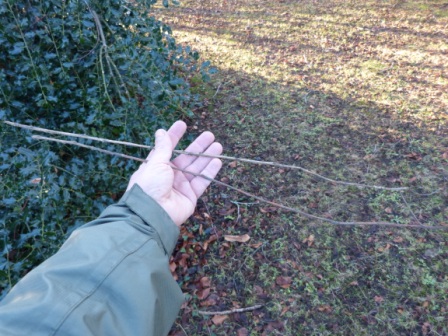
Holly trees have an abundance of thin, long, dry dead twigs attached to living branches - they are exceptionally good kindling (Photo: Sean Fagan).
.
2. FUEL The dead wood of holly burns hot and long as a fuel.
A lot of dead wood from holly trees has, for some reason, many small holes running throughout the wood which greatly increases its combustibility (more oxygen). The holes could be the remnant burrows of wood-boring insect larvae.
Many holly trees have large dead limbs still attached to the living tree. These sizable limbs are often vertical, or near vertical, and easy to dislodge (all they often require is a sharp shove to dislodge). The more vertically aligned deadwood is, the drier it usually is (sheds rain better).
Large, dead holly branches can be easily broken into shorter lengths by bashing the dead branches over something hard e.g. a large rock/boulder. No sawing or axe sectioning is generally required. However, be careful when forcefully breaking large branches as they can jar the hands when struck or break upwards - hitting an individual in the face.
.
3. CARVING WOOD Dense, smooth and often of clean, ivory-white colour – the wood is exceptionally attractive.
Although the wood can be hard to carve, it holds a hard wearing edge and is an ideal choice for robust carving projects, be warned – the wood can be prone to splitting at the ends when dried too quickly.
It’s important that holly wood has been dried (seasoned) gradually, especially if you are planning on using the wood for important carving projects, such as a knife handle.
.
4. FEATHER STICKS Admittedly, holly is not a first choice wood for feather sticks.
It’s hard to acquire sufficient lengths of holly wood that is knot-free. Also, dead holly tends not to yield long, multiple-curled shavings when carved.
However, it’s possible to make small feather sticks from holly – it’s just that more of them are required to make a large enough mass of curls for a sure-thing fire in damp conditions – anything between 4-8 feather sticks, even more.
How many feather sticks is exactly needed depends on your feather-stick making skills and the quality of the holly wood that you are using (make sure to make plenty of thin splints as well!).
So, why bother making inferiour feather sticks from Holly? There are deciduous woodlands that have a vigorous under-story of holly with few other tree species present. In those instances, holly can be the best feather stick choice and since bushcraft is very much about expanding our skill sets for all eventualities...
.
5. FLAMMABLE BARK Birch is not the only deciduous tree in town that has flammable bark.
Mature holly trees, especially standing, dead holly trees, sometimes shed a peeling bark that is flammable - certainly not as flammable as birch bark, nor does holly bark come off in the same copious quantities as birch bark – but off it comes, and its flammable - and can give you a fire-lighting edge when you need it.
.
6. BOW DRILL LUBRICANT The leaves of holly, when crushed, are fantastically waxy.
Holly leaves make a first-class lubricant for the handhold (bearing block) of the bow drill.
Personally, I admire the way my drill spins in the handhold when lubricated with holly leaves. Makes drilling a lot easier which enables me to spin my drill as fast as possible with less effort.
Seriously, I’ve found holly leaves to be a great bow drill lubricant and so will you.
Occasionally, I will put a few holly leaves in my backpack when the opportunity presents itself – just in case I decide to make a bow-drill fire in a location where holly trees are absent.
.
7. STRAIGHT, STRONG BRANCHES Not a whole lot of deciduous tree species naturally produce straight branches.
Of course, some tree species when coppiced, such as hazel and sweet chestnut, produce an abundance of straight branches. Un-coppiced holly is generous in its gift of straight branches.
Strong, long and tough – the straight branches that grow as secondary growth on the larger branches or a basal growth at the bottom of the main tree trunk have multiple, potential uses - shelter construction, throwing sticks, batons, digging sticks, arrows, walking staffs, spring traps and pot suspension are just a few applications for the straight, tough and long branches of holly.
It’s not hard to see why, historically, holly branches were once used for making spears and chariot axles.
.
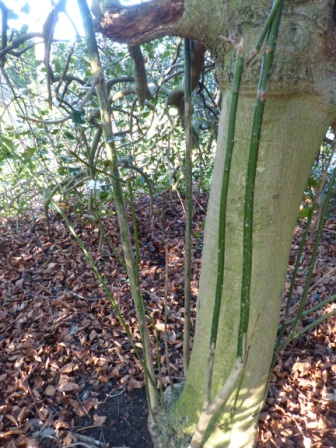
Straight and strong branches growing from the base of a holly tree. Holly branches are also quite elastic (high-tensile strength). (Photo: Sean Fagan).
8. SHELTER An unusual application of holly. The dense, evergreen canopy of holly can provide a discreet, well-sheltered site.
Many holly trees have a canopy that reaches close to, or to, the ground. Such trees are great for wildlife observation, or as a sheltered spot for sitting out inclement weather (while getting a quick brew on) or as a discreet camping site.
Just be mindful of the spiny leaf litter of hollies - some form of barrier is required to comfortably sit or lie under a holly tree. Alternatively - clear away the holly leaf litter from under the tree.
Bonus: the thick evergreen canopy of holly tends to disperse campfire smoke very well – important if you want to maintain a low-impact presence in an area.
.
9. LEAF LAYER OF DEBRIS HUT The thick, leathery leaves of holly provide great insulation for natural shelters such as the leaf-debris hut and the leaf-debris group shelter.
Rain tends to be shed off more efficiently from a shelter cocooned in holly leaves. Gathering the spiny, holly leaves can be challenging - usually some form of hand protection is required.
However, where there are holly leaves there are obviously – holly trees, so making a nice, natural shelter under a benevolent holly canopy can provide additional weather-buffing.
.
.
THINK FOR YOURSELF
WHY YOU SHOULD CONDUCT YOUR OWN BUSHCRAFT EXPERIMENTS
The above list of 9 bushcraft uses of holly is certainly not a comprehensive list of all bushcraft uses associated with holly.
It’s my hope that you create your own list of bushcraft uses for the holly tree - through your own bushcraft experiments.
Of course it’s important to avail of training courses, advice, research and experience as regards progressing your bushcraft knowledge, skills and experience.
It’s also vitally important that you draw your own conclusions from your own observations, deductive reasoning and experiments.
A key asset of any serious bushcrafter that actually spends a lot of time outdoors is fostering your own ingenuity – that you strive to acquire the confidence and get-go attitude to create and improvise for yourself.
Learn to trust your own ideas, and test them (as safely as possible). If they fail, so what? At least you tried and learned something about what works and doesn't work.
When you succeed you will plant a seed of confidence within yourself to trust your own observations.
This is important.
Books, training courses, other sources of valid bushcraft information etc. will only get you so far.
Wild places are variable at the best of times - they demand a flexible mindset to overcome some of the inevitable challenges that wild places will occasionally throw at you.
This is especially important if you plan on visiting, alone or with a group, a wilderness areas. It’s also important in survival scenarios.
Besides, figuring things out for yourself can be surprisingly satisfying - even fun. Whether its experimenting with unusual bushcraft applications of holly, or modifying a natural shelter design - its important that you occasionally flex and strengthen your ability to try things differently - on your own terms.
The art of applying competent, safe and novel ideas in a bushcraft setting, is a practise that improves with regular application. I will explore this theme more fully in a future article, so keep tuned : )
For now, I hope you enjoy becoming (re)acquainted with a fantastic bushcraft tree - holly.
HELP PRESERVE THE HOLLY
Finally, I’m going to briefly step onto my environmental podium and share a message I think is important.
In many places, there has been a serious decline in female holly trees due to the custom of cutting down berry-laden holly branches for Christmas.
Often there is a disproportionate ratio of male to female holly trees with male trees greatly outnumbering female holly trees because of local decimation of female holly trees.
If you are considering collecting holly berries, please refrain from doing so. Wild berries serve a much more vital function in nature - certainly more important than human decoration. The true Bushcrafter cares about nature and tries, when possible, to enhance a woodland rather than unnecessarily deplete its natural resources.
As a holly substitute consider the foliage of invasive tree species, such as cherry laurel, Prunus laurocerasus, and rhododendron, Rhododendron ponticum. Although both species lack red berries, the foliage is certainly pretty enough for Christmas wreaths. You will also be helping to control an invasive species.
Have Safe & Great Adventures, Pioneer Bushcraft. . Related articles on this website:- 9 Bomb-Proof Ways to Identify the Poisonous Fool's Parsley
- 7 Bushcraft Uses of Sycamore
- How Urban Botany will improve your Bushcraft
.
*Check us out on Instagram, Twitter & Facebook for more outdoor-related topics..
References:(1), (2) & (3): Trees of Ireland, Native and Naturalized, Nelson, E. Charles and Wendy F. Walsh.
Unfortunately, this is an expensive and difficult book to acquire, but its a great book. Highly recommended.
.
.
ADDITIONAL READING:
THE BIOLOGY & ECOLOGY OF HOLLY
HOLLY SHEDS IT LEAVES: Unlike most deciduous tree species, which shed their leaves annually, the evergreen leaves of Holly are replaced every 4-8 years. Holly trees located in urban areas shed their leaves more often, as frequently as once a year due to the effect of pollution (3).
SOIL TYPE: As regards soil preference, holly is unfussy and will thrive in both acidic and alkaline soils but dislikes very damp soil.
HERBIVORE DETERRENT: The purpose of the spiny nature of holly leaves is to provide a physical deterrent against herbivore consumption.
HOLLY HAS BOTH SPINY & NON-SPINY LEAVES: An interesting feature of holly is that the leaves of the lower branches are often spiny whereas the higher branches often possess non-spiny leaves. I was privileged once, to witness a large red deer, balancing on its hind legs - its forelegs delicately leaning against some holly branches as it strained it’s long neck and snout to reach some non-spiny holly leaves suspended at least 9 foot high. The deer was almost perfectly vertical. A surreal sight.
.
LIGHT & SHADE: Ecologically, the holly occupies some interesting niches. Holly can survive well in open areas and was often planted as a stock-proof barrier in field boundaries.
Holly is also shade tolerant and can thrive in the dimly-lit interior of deciduous woodlands during summer. Instead of competing against the taller deciduous tree species, the holly has retained its small stature in favour of producing foliage that can photosynthesis in low light conditions - a remarkable adaptation.
TRADITIONAL USES OF HOLLY: Some of the traditional uses of holly wood was inlay work, coffins and piano keys (stained black as a ebony substitute for black piano keys).
PIONEER BUSHCRAFT DISCLAIMER
.
Pioneer Bushcraft does not take responsibility for the misapplication of the advice dispensed in this article.
The aim of this article is to provide bushcraft applications for the holly tree – it’s not the wish of Pioneer Bushcraft to encourage over-exploitation of natural resources, such as holly trees.
Please, use good judgement when using natural resources. Only take what is needed and always have in mind: how much can be sustainably harvested from an area, which does not cause irreversible or serious long-term damage?
If you’re planning on repeatedly using an area for bushcraft practise you must be vigilant against over-exploiting vulnerable natural resources or you run the risk of greatly impoverishing your practise area.
In a sense, I’m encouraging a role of stewardship. Taking pride in caring for an area will enable you to become more attuned to, and more responsible about, the ecological health of a wild place that you frequent. It’s important for all those who practice bushcraft responsibly.

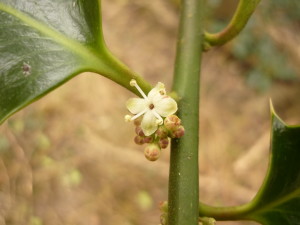
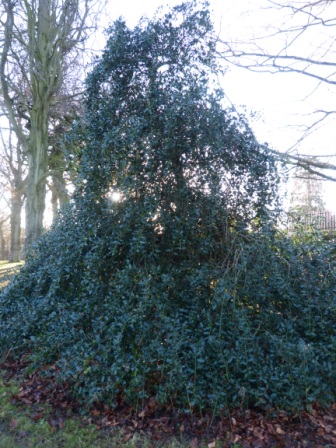
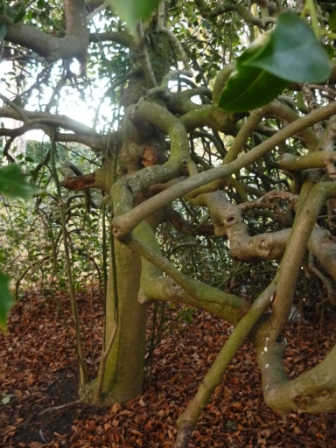
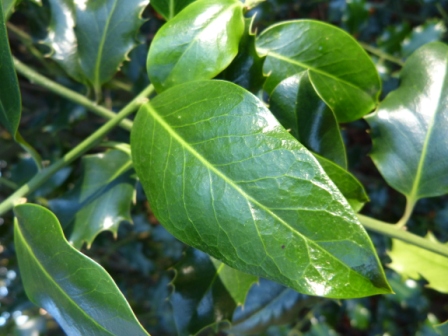

Recent Comments